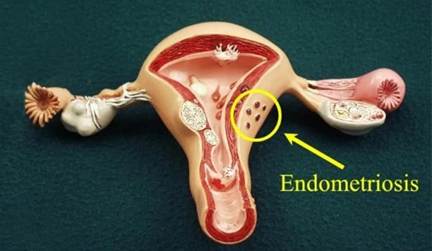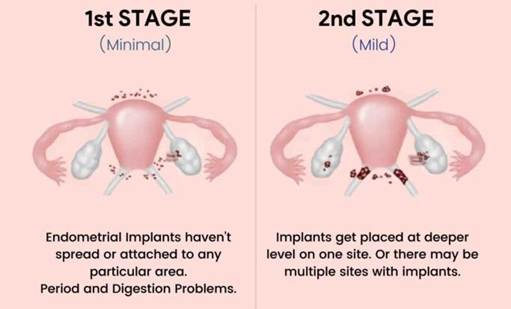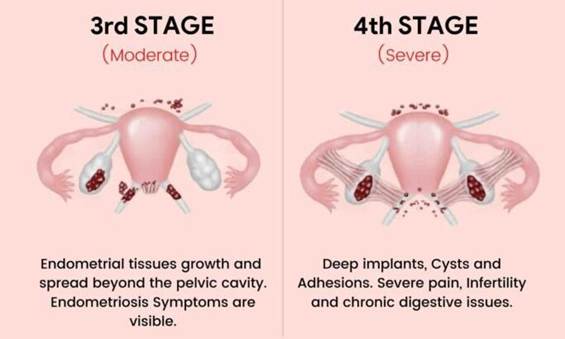Endometriosis: Symptoms, Stages, Causes, and Treatment
Endometriosis is a complex disease of the female reproductive system in which tissue similar to the lining of the uterus grows outside the womb. This disease can cause pain, fertility problems, severe menstrual cramps, menstrual delay, severe pain during and after sexual intercourse, and bowel problems. In this article, we discuss different symptoms and treatments of this disease and answer some of your frequently asked questions.
What Is Endometriosis?
Endometriosis is a prevalent condition in women where tissue similar to the lining of the uterus grows outside the uterus. This misplaced tissue commonly affects areas such as the pelvis, ovaries, fallopian tubes, peritoneum, and the space between the rectum and uterus. In some cases, endometriosis can also develop in surgical scars from procedures like C-sections or laparoscopy, as well as in the bladder, intestines, appendix, and rectum.

One of the primary symptoms of endometriosis is intense pelvic pain, which often occurs during menstruation but may also be present before or after the menstrual cycle. Unlike the normal uterine lining, which sheds during menstruation, endometriotic tissue outside the uterus does not exit the body, leading to inflammation, scarring, and other complications. Some of the significant effects of endometriosis include fallopian tube obstruction, painful intercourse, challenges in daily activities, and infertility.
Stages of Endometriosis
Endometriosis progresses in four stages, classified based on the location, size, depth, and number of lesions.
Stage 1: Minimal Endometriosis
This early stage is characterised by shallow endometrial tissue growth, with minimal symptoms such as:
- Inflammation within the pelvic cavity
- Small lesions on the ovaries
- Irritation in the intestines and bladder
- Pain during intercourse
- Severe menstrual cramps
- Heavy menstrual bleeding

Stage 2: Mild Endometriosis
Mild endometriosis has symptoms similar to the minimal stage but involves deeper endometrial tissue. Light adhesions develop in the ovaries and pelvic region, causing:
- Increased menstrual pain, especially in the last two weeks of the cycle
- Painful urination
- Nausea
- Constipation or diarrhea
- Discomfort during or after intercourse
Stage 3: Moderate Endometriosis
At this stage, the lesions are more widespread and extend deeper into the ovaries and pelvic lining. Cysts and adhesions begin forming in one or both ovaries, resulting in severe pelvic and abdominal pain. Stage 4: Severe Endometriosis

The most advanced stage involves extensive lesions in the pelvis, ovaries, fallopian tubes, and intestines. The deeper the endometrial tissue infiltrates, the more intense the pain and associated digestive issues become. Severe cases often require surgical removal of cysts to alleviate symptoms.
Infertility is a significant concern in stage 4 endometriosis, as it can lead to complications such as fallopian tube inflammation, poor egg quality, and conditions like adenomyosis. However, mild to moderate cases do not always result in infertility.
Symptoms of Endometriosis
Pelvic pain is the hallmark symptom of endometriosis, especially during menstruation. Other common signs include:
- Menstrual pain that does not respond to standard pain relievers
- Menstrual cycles lasting longer than seven days
- Heavy bleeding with blood clots
- Cycles shorter than 27 days
- Pain during urination or bowel movements
- Gastrointestinal symptoms like bloating, diarrhea, or constipation (often mistaken for irritable bowel syndrome)
- Painful intercourse
- Chronic lower back pain
- Nausea and vomiting
- Persistent fatigue
- Pain during medical examinations
- Depression and mood changes
- Spotting or bleeding between periods
- Leg pain
- Blood in stool during bowel movements
Since many of these symptoms overlap with conditions like ovarian cysts and pelvic inflammatory disease (PID), an accurate diagnosis is essential.
Where Does Endometriosis Cause Pain?
Pain from endometriosis is not limited to one area and can be felt in multiple locations, including:
- Bowel
- Fallopian tubes
- Ovaries
- Uterus and surrounding tissues
- Lower back
- Pelvic region
- Intestines
- Bladder
- Thighs
- Neck and shoulders
Causes of Endometriosis
The exact cause of endometriosis remains unclear, but several factors are believed to contribute to its development:
- Hormonal influence: Estrogen is known to aggravate endometriosis, which is why hormone-regulating treatments are often used.
- Genetics: A family history of endometriosis increases the risk.
- Stem cell growth: Stem cells in the pelvic and gastric mucosa may contribute to the development of endometriosis.
- Immune system disorders: A weakened immune response may fail to eliminate misplaced endometrial tissue.
- Embryonic cell transformation: Some hormones, including estrogen, may trigger embryonic cells to develop into endometrial-like tissue.
- Menstrual blood flow abnormalities: Instead of leaving the body, menstrual blood may flow into the pelvis or fallopian tubes.
Other risk factors include:
- Being over 35 years old
- Lack of regular exercise
- High caffeine and alcohol consumption
- Low body mass index (BMI)
- Early onset of menstruation
- Late menopause
- Congenital reproductive abnormalities
Complications of Endometriosis
- Chronic gastrointestinal issues (diarrhea, constipation, bloating)
- Nausea
- Heavy or irregular menstrual bleeding
- Infertility
- Painful cramping
- Ovarian cysts
- Bladder and intestinal dysfunction
- Increased risk of ovarian and breast cancer
- Tissue adhesion and scarring
- Chronic inflammation in affected areas
Who Is at Higher Risk for Endometriosis?
Endometriosis is more likely to develop in women who:
- Have a family history of the condition
- Are between 25 and 35 years old
- Have not had children
- Have experienced endometriosis previously
- Have long and irregular menstrual cycles (lasting more than seven days and occurring at intervals shorter than 27 days) • Started menstruating before the age of 12
Since endometriosis is strongly influenced by estrogen, women of reproductive age face a higher risk of developing this condition.
Diagnosing Endometriosis
- Ultrasound to detect ovarian cysts
- Medical history evaluation to identify symptoms and risk factors
- Pelvic examination to check for abnormalities
- Differential diagnosis to rule out other conditions
- Laparoscopy with biopsy to confirm the diagnosis
- MRI scans for detailed imaging
- Blood tests to measure specific markers
Treatment Options for Endometriosis
Since the exact cause of endometriosis is unknown, there is no definitive cure. However, various treatment approaches help manage symptoms, including:
- Dietary adjustments to reduce inflammation
- Pain relievers such as NSAIDs
- Laparoscopy to remove endometrial growths
- Laparotomy for severe cases
- Hormone therapy to regulate estrogen levels
- Surgical removal of the uterus and ovaries in extreme cases
- Progestin therapy to limit endometrial tissue growth
- Gonadotropin-releasing hormone (GnRH) agonists to lower estrogen levels
- Assisted reproductive technologies (ARTs) like IVF for fertility preservation
Endometriosis and Fertility
Endometriosis affects fertility in 30–50% of cases due to:
- Uterine scarring and adhesions
- Reduced egg production and quality
- Disruptions in ovulation
- Pelvic inflammation
- Hormonal imbalances
- Blocked fallopian tubes
Endometriosis and Recurrent Miscarriage
- Causing inflammation and scarring in reproductive organs
- Interfering with embryo implantation
- Affecting the uterine lining’s ability to support pregnancy
Women with endometriosis-related miscarriages may benefit from hormonal treatments, surgical interventions, or assisted reproductive technologies like IVF.
Endometriosis and Cancer Risk
While endometriosis does not directly cause uterine cancer, women with the condition have a higher risk of developing certain cancers, such as ovarian and breast cancer. Chronic inflammation and prolonged estrogen exposure increase the likelihood of malignancies.
By understanding endometriosis and its effects, women can seek early diagnosis and appropriate treatment to improve their quality of life.
| Consulting a fertility specialist can help you explore options for preserving | |
| your fertility and increasing your chances of a healthy pregnancy. | |
| Would you like more information on specific fertility treatments or egg freezing | |
| costs? Let me know how I can help! | |
